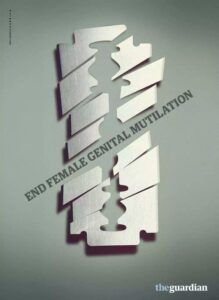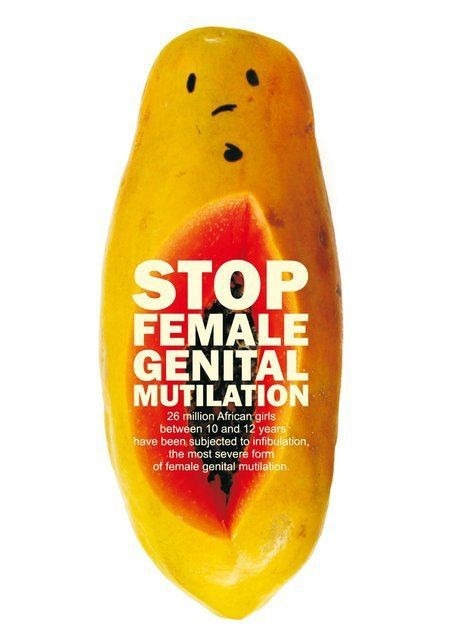In a world where the female gender has become an endangered species, the need to protect the female gender from being extinct cannot be overemphasized.

What is Female Genital Mutilation (FGM)?
The World Health Organization (WHO) defines FGM as “all procedure involving partial or total removal of the external female genitalia or injury to the female genital organs for a non-medical reason.
Female Genital Mutilation (FGM) is a term used by Human Rights Groups and health advocates to emphasize the physical emotional and psychological consequences associated with this procedure. This term also identifies the practices as a human rights violation because of the violence associated with the procedure and because it is mostly carried out on young girls and women
Types of FGM as Classified by World Health Organisation (W.H.O)
- Type 1 includes the partial or total removal of the clitoris and /or prepuce. Known as clitoridectomy.
- Type 2 is more an invasive procedure that includes the partial or total removal of the clitoris and the labia majora and is known as excision.
- Type 3 is the most severe type known as infibulation, which involves the narrowing of the vaginal opening with the creation of a covering seal that is formed by cutting and then stitching the labia minora and/or majora with or without excision of the clitoris.
- Type 4 of the FGM includes all other harmful procedures to the female genitalia including pricking, piercing, incising, scraping, and cauterization of the genital area.
The practice of FGM is a form of violence against girls and women that have been around for more than a thousand years. Every year, Four Million Girls and Women around the world are at the risk of undergoing FGM with most girls is going through the painful procedure before the age of Fifteen (15).
Traditional Basis for FGM
The Origin of FGM is unknown. However, the practice span across the countries of the world. The basis for the practice of FGM varies from community to community and from culture to culture.
FGM occurs among different religious sects although no religion requires it bur the practitioners of FGM believe the practice has a religious basis.
In many countries, the tradition is a deeply entrenched social norm rooted in gender inequality where violence against girls and women is socially acceptable.
FGM is often motivated by beliefs about what is considered acceptable sexual behavior which aims at ensuring premarital virginity and marital fidelity as the practice is believed to reduce a woman’s libido and as such help her to resist extramarital sexual intercourse.
In some communities, it is believed that undergoing the procedure increase marriageability of the girl or woman. The practice is also based on the strange belief that the girls and women are unclean by nature as a result of which they need to undergo FGM to be considered be clean.
Many traditions hold unto the practice of FGM as a means of passage of the girl child to womanhood.

FGM a Violation of the Human Rights of Girls and Women
Despite many claims to the traditional basis for FGM, the practice is nothing but a sheer violation of the human rights of both girls and women.
The term Female Genital Mutilation FGM was first used in the 1st international Document to specifically address the practice, the Programme of Action adopted by the International Conference on Population and Development in Cairo, Egypt in 1934. The Programme refers to FGM as a basic Rights Violation and urges Governments of different countries to prohibit and stop the inhuman and degrading practice.
International agreements Statements and Treaties such as the United Nations Convention on the Elimination of All Forms of Discrimination Against Women (UNCEDAW) adopted in 1981, the United Nations Convention on the Rights of the Child (UNCRC) 1986, and the African Charter on the Rights of the Child includes languages applicable to FGM. Parties to these Conventions and the Charter are to ensure the rights of women and girls enshrined in the Documents are protected.
In the platform of the Fourth World Conference on Women, held in Beijing in 1995, Female Genital Mutilation was cited as both a threat to women’s reproductive health and a violation of their human rights.
In addition to making general recommendations, the Platform specifically called on governments to “enact and enforce legislation against the perpetrators of practices and acts of violence against women, such as Female Genital Mutilation…” Notably the drive to include language specifically condemning Female Genital Mutilation was moved by Africans.
FGM violates the human rights of children and women, among such rights are:
- Right to Life
It is the inalienable right of every human to have the right to life and is enshrined in the constitutions of countries of the world. As a result of which any practice such as the FGM an irreversible procedure, inflicts severe pain and is life-threatening to the lives of any girl or woman threatens the survival of humanity. Therefore, FGM which has for many years posed a danger to the lives of women should be eradicated in its entirety from the surface of planet earth.
- Right to health
The practice of FGM has no health benefit but only results in excessive harm to the woman and the girl gender. Since the procedure involves the total or partial removal of the female genital, it interferes with the natural functioning of the girl or woman’s body.
Whenever young girls and women are cut, they are liable to bleed severely, or they become susceptible to a serious infection like urinary tract infection, especially when unsterile cutting instruments such as razor blades, knives, scissors, etc. are used. In many communities, FGM operations are performed by untrained health workers who know nothing about medical care and as such the procedures are done haphazardly without any reckon to utmost medical care. FGM is a medically unnecessary and irreversible procedure that damages the health of millions of girls and women worldwide. In most instances, many of the victims of FGM have been rendered infertile as a result of the health implications.
Article 24 of the United Nation’s Convention on the Rights of the Child (UNCRC) 1989, provides as follows:
“States Parties shall recognize the right of the child to the enjoyment of the highest attainable standard of health and facilities…”
Therefore, FGM being a practice that disregards the highest standard of health is an infringement on the rights of the girls and women and girls which cannot be tolerated.
Below are some of the complications the victims of FGM suffers either on a short term or long-term basis:
- Urinary Tract Infections
- Severe bleeding
- Excessive pain
- Injuries to the genital area
- Shock
- Wound healing problems
- Virginal problems such as itching, discharge, infections
- Mensuration problems
- Sexual problems such as painful sexual intercourse, lack of sexual satisfaction
- Childbirth complications
- Psychological problems such as depression, anxiety, post-traumatic stress disorder (PTSD)
- Death

- Right to be free
In the communities where FGM is the order of the day, the woman is seen as an asset of monetary value to the family and community and as such she is not free to express her opinion as regards anything regarding her body, therefore, she has no choice in whether the procedure will be performed on her or not.
- Freedom from violence •
The practice of FGM is a form of violence against girls and women that have been around for more than a thousand years.
- Right to non-discrimination
FGM spells nothing but discrimination against the female gender. The perpetrators of the tradition advocate that the procedure guides girls and women against sexual promiscuity both before and after marriage. While its origins are unclearly eradicating the practice will bring the world one step close to achieving gender equality.
Ending FGM is a key part of UN’s Sustainable Development Goal 5 for achieving Gender Equality 2030.
- Right to be free from cruel, inhuman, and degrading treatment.
FGM is a cruel, inhuman, and degrading procedure that reduces the girl or the woman and makes them subject to the whims and caprices of their families and communities. The prolonged negative impact of FGM cannot be overemphasized as it leaves its victim with leads to long-term physical and psychological consequences, lasting a lifetime.
Article 37 (a) of the United Nation’s Convention on the Right of the Child provides:
“States Parties shall ensure that no child shall be subjected to torture or other cruel, inhuman or degrading treatment…”
FGM is nothing but torture, cruel, inhuman, and degrading treatment to which every girl or woman shall be protected against.
In conclusion, all effort must be geared toward putting an end to this unwholesome practice. The Government, communities, health care professionals, and organizations that uphold the right of the woman and the girl child must work together to achieve the one goal of ending the menace called Female Genital Mutilation.
REFERENCES
- World Health Organisation: Female Genital Mutilation: An Overview. Geneva: World Health Organisation; 1998.
[Google Scholar]
- United Nations: Convention on the Rights of the Child (UNCRC) 1989
[Google Scholar]
Photo Credit
Graham Ash-Porter









